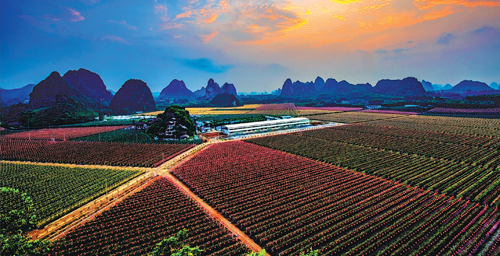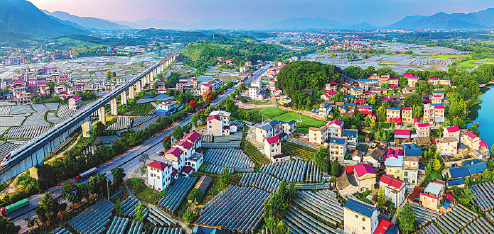Guangxi's fruitful agricultural achievements

Officials innovated and modernized the industry during 13th Five-Year Plan
The fruitful achievements in the agricultural industry made in South China's Guangxi Zhuang autonomous region demonstrated the local government's efforts to realize modern agriculture during the 13th Five-Year Plan (2016-20) and signaled the direction for next-stage development, the local government said.
Through a series of innovation in optimizing industrial layout, the region has developed a modern seed industry, improved the quality of its products and established Guangxi's signature brands, an official said.
The government eyed high-quality projects and pushed forward industrial upgrades.
The Party committee and government decided to improve the variety and quality of local products as well as brands' added value, beginning in 2015.
It identified 10 planting and breeding products with Guangxi characteristics and three emerging industries of selenium-rich agriculture, circular agriculture and leisure agriculture and took action to develop them.
Defining 2015 to 2017 as its first development stage and 2018 to 2020 as its second stage, the government implemented the actions throughout the period of the 13th Five-Year Plan.
Based on the actual situation, 14 cities in the region have launched actions to improve their brands in accordance with the region's overall instruction.
The entire autonomous region has worked together to build six major industrial clusters with a 100-billion-yuan scale, covering grain, sugar canes, fruits, vegetables, fishery and high-quality livestock.
Three new industries of sericulture, traditional Chinese medicine and high-quality poultry, whose scale reached 50 billion yuan ($7.8 billion) each, emerged during the period.
The output value of leisure agriculture exceeded 40 billion yuan, with the output value of the tea industry reaching 25 billion yuan, and selenium-rich agriculture reaching 6 billion yuan.
In January, the work report of the region's government announced its ambition to continue the brand-polishing actions during the 14th Five-Year Plan period (2021-25) and implement it to boost modern agriculture.
Its second effort is about strengthening the role of high-value seeds in the industrial layout and constantly enhancing the influence of Guangxi's seed industry in China and Southeast Asia.
The "super rice and reproducible rice" project, which is working together with academician Yuan Longping's team, can yield 104 kilograms per hectare, a new world record.
A number of rice varieties, such as Yexiangyou and Guiyu, have won gold medals in national competitions.
Guican No 8, which can produce high-grade raw silk, is a new variety cultivated in the region. After years of research, its breeding capability is said to be in the highest in the world.
The coverage rate of sugar cane varieties independently developed in Guangxi has so far reached 66 percent, which has ended the dominant position of imported varieties. Guitang No 42 and Guiliu No 05-136 have become the most dominant varieties.
The Guidan variety, an innovated corn seed independently bred in the region, has put an end to foreign brands' dominant role over the past 20 years.
The local government paid close attention to quality monitoring and strived to build a series of supply bases for green agricultural products.
Relying on 339 key modern agriculture demonstration bases, it built up a series of brands of agricultural products exported to Shenzhen, Hong Kong and outbound regions, and created four groups of advantageous agricultural products.
There are 18 agricultural product advantage areas identified as having Chinese characteristics.
After actions to promote a green production mode, popularize soil testing, green fertilization and pest control technology, the use of chemical fertilizers and pesticides in the region has dropped for five consecutive years.
The local government also launched a three-year plan to restore live pig production, introduced nine measures to support the high-quality development of the cattle and sheep industry, implemented five actions to promote green and healthy aquaculture, and promoted ecological breeding models.
The region paved a way to improve the brand image of "Guangxi Haoye (Guangxi's good things)" agricultural products and made efforts in geographical certification.
Geographical indication is a label given to products that possess a specific geographical origin with special qualities or reputations, according to the World Intellectual Property Organization.
The local government worked to obtain the label of organic, green and geographical indication for its agricultural products during the period. A total of 531 green food products, 144 organic foods and 147 other geographical indication agricultural products were certified.
So far, 285 brands have been selected into the Guangxi Haoye project, with a total brand value of more than 250 billion yuan.

A demonstration area of organic grape and tourism in Guangxi Zhuang autonomous region. CHINA DAILY














